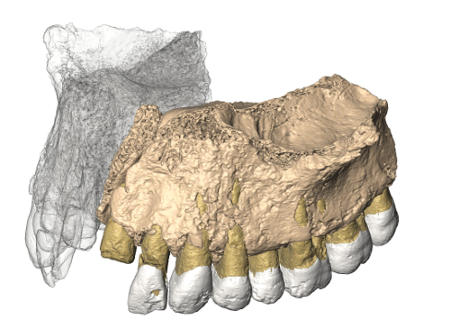Using AI to control energy for indoor agriculture
30 September 2024
Published online 10 February 2018
Find provides crucial new data, re-writing the story of human evolution and our dispersal from Africa.

© Tel Aviv University
Misliya Cave’s roof collapsed roughly 160,000 years ago, sealing an early modern human maxillia (upper jaw bone) and teeth alongside stone tools and other habitation debris, according to Israel Hershkovitz, the study’s lead author from Tel Aviv University. “The cave itself was never again occupied by any other later hominid groups, so we are absolutely sure that the fossil was not an intrusion,” says Hershkovitz.
Hershkovitz says dating and identifying the specimen was challenging. “It could have been Neanderthal, modern human, heidelbergensis, or who knows what?”
The team micro CT scanned the fossil to make a 3D model so they could compare it with jaw bones “from similar time periods from different parts of the word and of different hominids,” explains Hershkovitz.
Researchers dated the fossil directly by testing, in three different labs, the jaw and its patina, as well as burned flint found near the fossil. All the dates clustered “in a very small range somewhere between 177,000 to 194,000 years ago,” according to Hershkovitz.
Christopher Bae, a paleoanthropologist at University of Hawai‘i at Mānoa, who was not involved with this study, says “the evidence seems to be fairly solid in terms of it being modern human.”
Likewise, Katerina Douka, archaeological scientist at Max Planck Institute for the Science of Human History in Germany, also not associated with the study, is convinced of the biological analysis, but cautions that “without larger pieces of this skeleton, you have to be careful with what you can say.”
The out-of-Africa model theorized that humans migrated out of Africa in one big push around 60,000 years ago. At 177,000 – 194,000 years-old, the Misilya Cave jaw provides evidence to disprove this theory.
This find is among a host of other discoveries pushing back the date of human evolution, for example the 300,000 year-old earliest modern human fossil from Jebel Irhoud, Morocco2 3, and showing an earlier and more varied pattern of human migration out of Africa, such as a recent study supporting the presence of modern humans in Asia 120,000 years ago.4
Douka says this find “confirms the current thought in the community that there was not a single wave out of Africa, but frequent expansions which often failed.” Bae adds, “New data like the evidence from Misliya Cave and other areas of Asia is really forcing us to re-think many of our ideas of modern human origins.”
This find, according to Hershkovitz, links recent discoveries so that now “everything starts to make sense.”
doi:10.1038/nmiddleeast.2018.15
Stay connected: